Sunday, April 27, 2008
another nose job
Still trying to sort out the profile of the tank. probably will try something where the upper side is a more shallow curve than the lower. This is closer to what I'm thinking, tho it seems a bit conservative:

Sunday, April 20, 2008
dreaming
Blunt or sharp nose tank. Decisions, decisions...One thing I really disliked about these studies is the junction between the tank and the saddle. It's not something obvious at first but I can see that the vertical line deviating the two pieces does not flow at all with the frame tubing slanting forward from the rear swingarm pivot. whatever the junction made between the saddle and the tank, it should most likely be parallel with that frame tube because it's such a strong line in and of itself (I think)


Saturday, April 12, 2008
Fitting the airbox
So Banke will need the engine/airbox once we get further along in the process down there. Time to test out attaching the carb rubbers and see how it all goes together. I tried to make the forward half of the airbox a fair approximation of the stocker. Just trace the holes onto the new part with a pencil and cut them out with the Dremel of Fear.

Spent a little more time wet sanding after the holes were cut to get a reasonable finish

Intake rubbers fit on just fine, look like they'll take a little silicone sealant or the like just fine.


Spent a little more time wet sanding after the holes were cut to get a reasonable finish
Intake rubbers fit on just fine, look like they'll take a little silicone sealant or the like just fine.
Tuesday, April 8, 2008
Banke Status
OK! Ventured down to James Banke's shop this afternoon, and thrilled at seeing the bike up on his table with cuts/welds/grinds in earnest. This is a fun project!
Perhaps the biggest frame revision involves repositioning the top rear triangle rails to be horizontal. This is kind of important to build into the frame because street trackers have a minimal saddle tank configuration that requires any adjoining space be taken up by the frame. Because the bolt securing the top of the monoshock needs room to be backed out for disassembly, we couldn't have both the rails extend directly towards their horizontal position on the frame backbone. James came up with a simple workaround to have one side rail curve downwards at its forward joint so there would be room for the bolt to back out. This asymmetrical configuration to me is REALLY COOL because it's so purposeful and simple. I think it coincides excellently with my plans to fabricate a custom seat pan showcasing this design. It will only add to the overall effect.
Here, in yellow we see where the left side rail will be finished, and the blue lines roughly illustrate where the right side rail will accomodate the shock bolt:

I'm also blown away with how the rear brake has taken shape. The pedal from the existing bike was repurposed to modulate the linkage that drives the Brembo plunger here. This is the sort of creative reuse of old objects for the present that inspires me to be a part of architectural restoration!

Here we see how the rear caliper attaches to it's mounting bracket. The word "Tumble" is written to indicate the type of finish, and we'll do a simple 1" hole in the center of the bracket for aesthetics. Bracket is an aluminum plate that uses the axle as it's main mounting point, and then there's a slot on the other side of the swing arm where it is "Keyed" onto a nubbin much like the drum brake originally was to keep the assembly from spinning when the brake is applied.
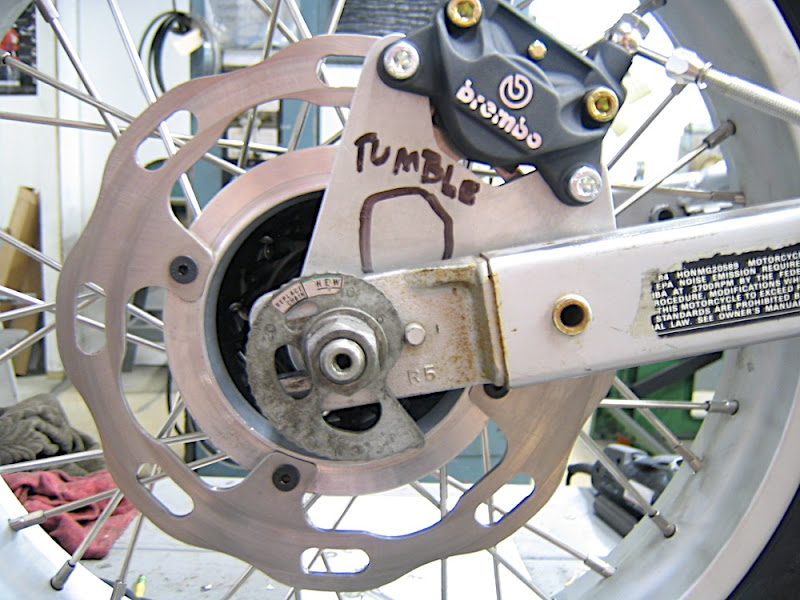
Another shot of the rear brake assy.

The other side of the rear hub where there is plenty of angle grinder action evidenced :)

Here's an establishing shot of the 3/4 view. Yes, that's a BSA in the background.

Forks have also been successfully shortened with extra beef and less cheese.
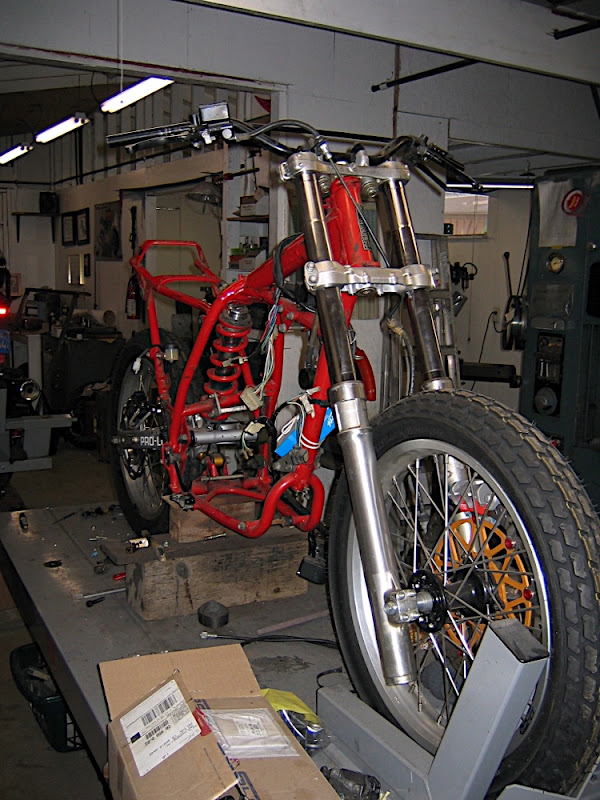

Perhaps the biggest frame revision involves repositioning the top rear triangle rails to be horizontal. This is kind of important to build into the frame because street trackers have a minimal saddle tank configuration that requires any adjoining space be taken up by the frame. Because the bolt securing the top of the monoshock needs room to be backed out for disassembly, we couldn't have both the rails extend directly towards their horizontal position on the frame backbone. James came up with a simple workaround to have one side rail curve downwards at its forward joint so there would be room for the bolt to back out. This asymmetrical configuration to me is REALLY COOL because it's so purposeful and simple. I think it coincides excellently with my plans to fabricate a custom seat pan showcasing this design. It will only add to the overall effect.
Here, in yellow we see where the left side rail will be finished, and the blue lines roughly illustrate where the right side rail will accomodate the shock bolt:

I'm also blown away with how the rear brake has taken shape. The pedal from the existing bike was repurposed to modulate the linkage that drives the Brembo plunger here. This is the sort of creative reuse of old objects for the present that inspires me to be a part of architectural restoration!
Here we see how the rear caliper attaches to it's mounting bracket. The word "Tumble" is written to indicate the type of finish, and we'll do a simple 1" hole in the center of the bracket for aesthetics. Bracket is an aluminum plate that uses the axle as it's main mounting point, and then there's a slot on the other side of the swing arm where it is "Keyed" onto a nubbin much like the drum brake originally was to keep the assembly from spinning when the brake is applied.
Another shot of the rear brake assy.
The other side of the rear hub where there is plenty of angle grinder action evidenced :)
Here's an establishing shot of the 3/4 view. Yes, that's a BSA in the background.
Forks have also been successfully shortened with extra beef and less cheese.
Wednesday, March 12, 2008
seatpan prototype
Starts with the plug on the right, then a female mold on the left there.

Readying everything for the part layup. It's a lot of messing around with six layers of glass cut into facets, then peel ply, then breather cloth. Oh, and a vacuum bag that'll hold the goopy mess once it's ready for curing!

Here we see the layup in progress. I'm experimenting with pigmenting the resin so that I don't have to bother with painting (the fumes would overpower the shroomy mellow of my petite domecile). This isn't quite orange enough for the Honda flash red that I like:

I wrote a neurotic little passage on Instructables.com on how I do the bagging stuff. So far this assembly is holding it's pressure, so that's good. Just hope the resin cures:
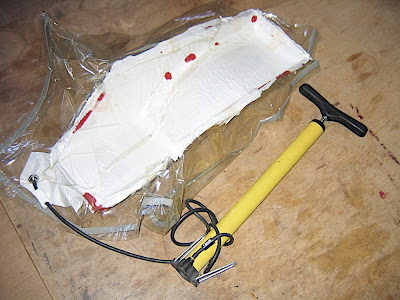
And here's the raw piece, ejected from the mold. Has a few boogers where the PVA dripped on the mold, but no big deal for a prototype.
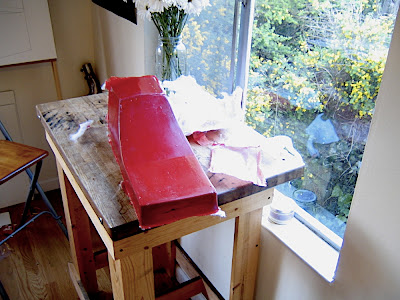
My main concern for this exercise was voids in the layup. This particular run had a lot of epoxy+milled glass fiber smeared in the corners to help fill in these areas that are typically hard to cover well with cloth and resin alone. I added too much, tho, and you can see how the peel-ply left a bit of a crease in the corner from smooshing the resin slurry to either side. Less next time?
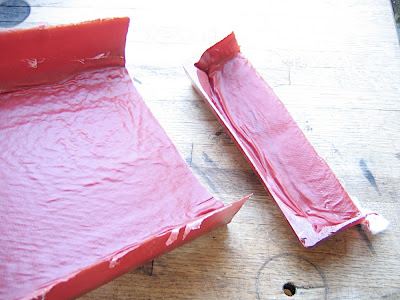
Readying everything for the part layup. It's a lot of messing around with six layers of glass cut into facets, then peel ply, then breather cloth. Oh, and a vacuum bag that'll hold the goopy mess once it's ready for curing!
Here we see the layup in progress. I'm experimenting with pigmenting the resin so that I don't have to bother with painting (the fumes would overpower the shroomy mellow of my petite domecile). This isn't quite orange enough for the Honda flash red that I like:

I wrote a neurotic little passage on Instructables.com on how I do the bagging stuff. So far this assembly is holding it's pressure, so that's good. Just hope the resin cures:

And here's the raw piece, ejected from the mold. Has a few boogers where the PVA dripped on the mold, but no big deal for a prototype.

My main concern for this exercise was voids in the layup. This particular run had a lot of epoxy+milled glass fiber smeared in the corners to help fill in these areas that are typically hard to cover well with cloth and resin alone. I added too much, tho, and you can see how the peel-ply left a bit of a crease in the corner from smooshing the resin slurry to either side. Less next time?

Sunday, February 10, 2008
chassis on wheels
Ventured down to Banke Performance to go over the bike now that it was up on wheels. James laced up Sun rims to a CRF front hub, and a new rear hub made by Rad Racing that has a cush drive. He spent a lot of time one afternoon going over the choices and we ended up going with a cush drive so that the final drive in the engine is spared the direct shock of all the wheelies and clutch dumping burnouts I plan on doing. The stocker had cushdrive anyway, so it made a lot of sense to continue. The wheels are absolutely smart looking, and I'm very happy with his machine work to get them to fit into the existing configuration. We're opting for a rear disc brake over the stock drum. And check out that 320mm front rotor. As James says: "We want this bike to be able to stop." Yes!
Here's the frame with the gorgeous wheels, image edited to show where frame rails will be truncated, some tabs removed:

I think we both were surprised at how well the bike would take to the new configuration. James scored a pair of '90 CR500 43mm cartridge forks for the build, and their tripple clamps went on no probs, apparently. He'll have them shortened a bit, but for now, we just slid them down in the triples to get an idea of how the bike would look. I can't get past the wheels, myself, but it looks really well!
A rough outline of how the seatpan assy will be oriented. Gotta go with the XR750 fender shape:
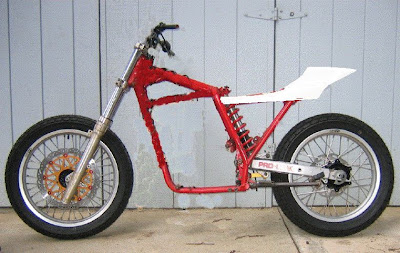
I did a rough sketch of frame revisions that will take place here:
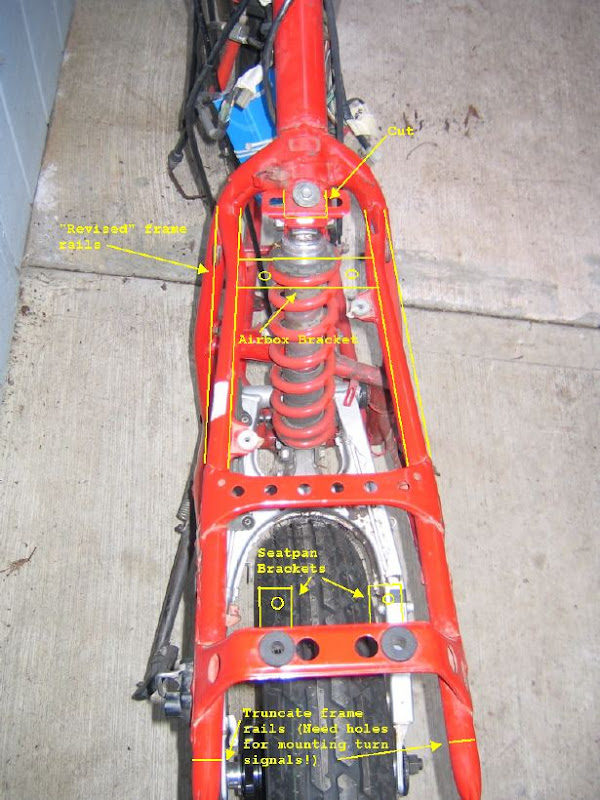
Here's the frame with the gorgeous wheels, image edited to show where frame rails will be truncated, some tabs removed:

I think we both were surprised at how well the bike would take to the new configuration. James scored a pair of '90 CR500 43mm cartridge forks for the build, and their tripple clamps went on no probs, apparently. He'll have them shortened a bit, but for now, we just slid them down in the triples to get an idea of how the bike would look. I can't get past the wheels, myself, but it looks really well!
A rough outline of how the seatpan assy will be oriented. Gotta go with the XR750 fender shape:

I did a rough sketch of frame revisions that will take place here:

Monday, December 31, 2007
Engine Reassembly Part II
There was still a lot of residue from material blasting the head, so I needed to clean it well with spray carb cleaner, and compressed air. I have no air compressor, so I stole an idea from instructables.com to make a simple air blower from an empty spray can, the presta valve from a bicycle tube, and JB Weld. Redneck Air cans are GOOOOO!
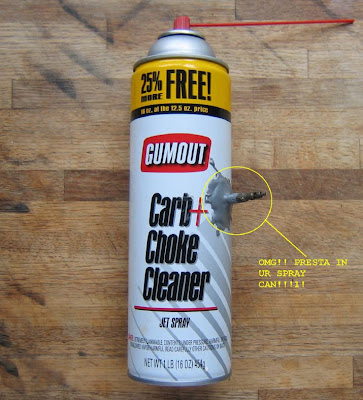
Cam chain tensioner install is pretty mean with the need to preload the spring all the way "open" so that it does not interfere with the cam/sprocket/chain reassembly. I rednecked a tool to hold it open out of wire:
The string (floss) helps guard against it falling into the bowels of the motor
One last check before saying goodbye to the head
All closed up!
Subscribe to:
Posts
(
Atom
)



